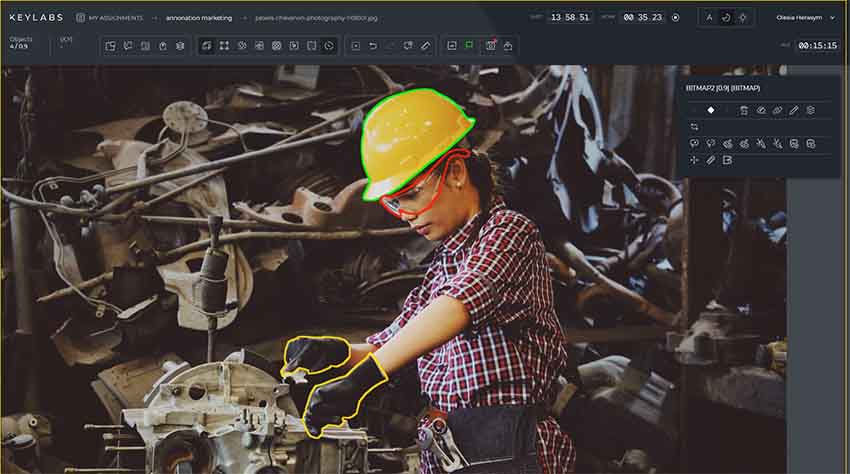Interview with Arie Zilberman, Founder & CEO of Keymakr Data Labeling.
How was 2023 for your business, a short summary?
Arie Zilberman: Reflecting on 2023, it’s been a year of complex challenges and significant developments for us at Keylabs. The global situation has been unpredictable, presenting us with unique hurdles, particularly in our data annotation services sector. We’ve witnessed a substantial industry shift, driven primarily by the expanding influence of AI.
AI’s omnipresence is undeniable, especially in our core areas of image and video data annotation. Here, we’ve seen a fascinating dynamic unfold – a kind of tug-of-war between traditional real datasets and the emerging force of synthetic data. Our stance and experience in this domain are quite clear. While synthetic data offers apparent advantages in terms of cost and speed, it brings its own set of challenges. Developing a model and managing the entire process of producing these datasets requires either a reliable external supplier or an in-house team dedicated to this task.
However, the crux of the matter lies in the quality of the data. There’s an inherent bias in synthetic data that can’t be overlooked. The recent tragedy at a Korean warehouse is a stark reminder of the potential consequences of over-relying on synthetic data in processes involving human elements. As the CEO of Keylabs, I hold a strong conviction that reliance on synthetic data in such sensitive areas is not advisable. It’s crucial to strike a balance, ensuring that the quality and reliability of data are not compromised in the pursuit of efficiency and cost-effectiveness.
What products/services did you launch this year?
A.Z.: As CEO of Keylabs, I’m thrilled to share that 2023 has been a year marked by significant innovation and strategic adaptation for our team. We’ve taken a bold step forward by enhancing our proprietary data annotation platform, Keylabs, with a state-of-the-art ML-assisted tool. This pioneering addition is more than just an upgrade; it’s a game-changer in the world of data annotation. It enables a harmonious blend of various modeling approaches and unifies manual and automated annotation processes within a single, streamlined project.

Our R&D team, who are constantly pushing the boundaries of what’s possible, have outdone themselves this year. They’ve developed revolutionary features like edge smoothing and healing tools, specifically designed to address the shortcomings in AI-generated annotations. These tools are meticulously engineered to correct and refine inaccuracies, effectively filling in the gaps and perfecting the edges that AI alone might miss. This not only bolsters the accuracy of our annotations but also significantly conserves resources.
I’m personally very excited about these developments. They represent not just our commitment to innovation but also our dedication to delivering unparalleled precision and efficiency in our services. As we look ahead, I’m confident that these enhancements will have a profound impact on the way we operate and the quality of service we provide to our clients. We’re not just keeping up with the industry; we’re setting new standards for what technology can achieve in the realm of data annotation.
How did the market change, compared to previous years?
A.Z.: Despite the widespread availability of datasets across various industries, the field of data annotation continues to experience significant growth and development. It remains a vibrant sector, consistently attracting substantial budgets for new initiatives and projects.
In recent times, there has been a notable shift towards the use of synthetic datasets. However, as previously mentioned, the issue of precision with these datasets is still a matter of concern. When utilizing AI for automated data annotation, there is the advantage of being able to correct and validate the results through human intervention. In contrast, when synthetic data is used, the human element is often completely removed from the process. This can be problematic, as AI, in its current stage, may not be fully equipped to handle all aspects of data annotation without human oversight.
I understand the growing popularity of these methods. On the surface, they appear more cost-effective and user-friendly. However, for most industries, particularly those of us working in data annotation, there is a critical need to find a balance between cost efficiency and performance. While embracing new technologies and methodologies can drive innovation and reduce expenses, it’s crucial to ensure that the quality and accuracy of the data are not compromised. This balance is essential for maintaining the integrity of the data annotation process and ensuring that the final outputs are both reliable and effective.

How did you overcome these challenges in this more competitive environment?
A.Z.: I think it’s the most challenging point for data annotation suppliers for 2024.
On our hand, we provide both services and data annotation platform, as well as data creation and data collection opportunities, tailoring the data unique and precise for specific needs of each project.
Combining quality raw data, AI-data annotation and human control is Keymakr’ complex answer to all challenges and changes 2024 is bringing on the table.
What do you think the trends will be next year?
A.Z.: The trends in data annotation services for 2024 are expected to be profoundly influenced by the increasing integration of AI across various sectors. This expansion of AI is anticipated to drive a greater demand for data, further emphasizing the role of synthetic data in various applications. As AI becomes more prevalent, the nature and type of data required for its training and operation will evolve, leading to an increased reliance on sophisticated data annotation tools and services.
The emphasis will likely be on developing more advanced, efficient annotation tools that can keep pace with the growing complexities of AI models. Automation in data annotation will become more refined, focusing on enhancing accuracy while reducing the time and labor involved in manual annotation processes.
Moreover, the human role in data annotation is expected to shift towards oversight and quality control, managing the initial setup and final verification stages. This change reflects a broader trend in AI and technology, where human expertise is leveraged for higher-level decision-making and oversight, rather than routine tasks.
From a broader perspective, the interplay between AI and data annotation will likely spur innovation in both fields, with each driving advancements in the other. As AI capabilities grow, so too will the sophistication of data annotation tools, leading to a more seamless and integrated approach to AI development and deployment.

What is the outlook for 2024?
A.Z.: We are more confident and stronger than ever before. Newcomers to the data annotation field should be frightened.
However, we recognize that expertise is the crucial value in our field. We have much to offer the market.
Operating since 2015, we have expertly trained an in-house team of over 400 annotators specialized in various industries, based in one of our three offices across Europe and the USA. We provide human support, mostly available 24/7. These features are truly unique in the data annotation market. We do not employ a “black labor force” and are not tied with time zones’ differences.
We strive to serve our clients’ businesses better than anyone else has before.
https://www.youtube.com/@keymakr5796

